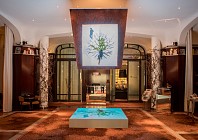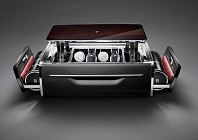“Have you eaten yet?” is the standard greeting that illustrates China’s obsession towards food. Communism turned Beijing into a city of communal canteens until the city’s first private restaurant opened in 1980, which is still open for business today. Over the coming decades, more and more private restaurants opened but quality was unknown. When the 2008 Summer Olympics began, China presented its modern city image to the world but still, the capital’s dining scene seemed to struggle to reach high levels of esteem. Since then, China’s opened itself to capitalism, sprouting a flurry of cottage industries as new wealth and more opportunities to travel brought a taste for luxuries found abroad.
Quality and consistency were the immediate problems, followed by a peak of food safety issues and a suspicion of local products that has fostered a demand for imported ingredients. Now, a collective of local farms is growing steadily, and Beijing’s restaurant scene has upped its pace from a painful crawl to a brisk jog. Once a desert for fine dining, Beijing is now catching up at lightening speed with an inundation of cuisines never before seen in the city.
Ignace Lecleir, proprietor of TRB – Temple Restaurant Beijing, describes the change in diner demands: “I believe people have come to associate the words ‘fine dining’ with an overall experience rather than any single aspect of the meal. We also certainly see a stronger appreciation towards service/hospitality in this market, and favour towards not necessarily expensive but rather creative dishes.”
Beijing’s most famous dish, Peking roast duck, is easily found and will always be a must-try for visitors. Of China’s 36 provinces, almost every one has representation in Beijing, with provincial government restaurants attached to hotels that offer local visiting officials and guests a true taste of home. Smaller homestyle and private kitchens are also opening, the secret back doors that hide great meals and their clandestine government diners from peering eyes that have come under reform scrutiny. Sichuan and Yunnan provincial cuisines are beloved as much as simple dumpling restaurants that are typical of the city.
Beijing’s dining scene is multifaceted, with massive eateries that have developed to accommodate the city of 24 million. Gourmet options grow steadily as new wealth has created the world’s fastest growing economy and a taste for luxury that is feeding a demand for fine dining. Beijingers are building up an appetite for more variety although Chinese standards differ from the west, mostly when it comes to service. Local eateries can be a cultural experience and a curious discovery with a myriad of options. Food trends come and go, but one thing holds true: the Chinese love to eat, especially in the capital, and there has never been a better time to taste Beijing’s best.
TBR - Temple Restaurant Beijing

Colors and flavours fuse at TBR
TRB is set within the complex of a 600-year-old Qing dynasty Tibetan Buddhist temple that was once China’s first television factory. Owner Ignace Lecleir is a graceful host who has single-handedly elevated restaurant dining in Beijing, and invites celebrated guest chefs from around the world to come and create special menus using local products. Diners delight in modern European cuisine that is seasonal and beautifully presented. A velvety pumpkin soup is delicately spiced with curry and ibérico ham, and a theatrical presentation of house-made gravlax is served table-side. Lecleir is a also a sommelier and can masterfully recommend local pairings to enlighten a meal and educate diners on
23 Shatan Beijie, off Wusi Dajie, Dongcheng; +86 10 8400 2232
Opera Bombana

Short rib and beef tenderloin, red wine and plum sauce with whipped potato
Since 2013, Umberto Bomba’s Beijing offshoot of his Hong Kong three-star Michelin, 8 ½ Otto e Mezzo Bombana has been making a splash, giving diners a taste of Northern Italy Opera’s towering dining room of natural wood tones with art from Andy Warhol, Chinese artist Wu Ming Zhong and Korean artist, Jiang Heng Jiu. Chef de cuisine, Marino D’Antonio skillfully orchestrates handmade pastas including chestnut tortelloni with pancetta and brown butter sauce. Signature dishes that appear on the degustation menu include a crudo of New Zealand langoustine and caviar from northern China’s Heilongjiang province. Reservations, especially for dinner, are recommended.
Parkview Green FangCaoDi, 9 Dongdaqiao Road, Chaoyang; +86 10 5690 7177
Transit

The chic interior of Transit
Transit was once a small local eatery that was shuttered and resurrected in the Sanlitun area. Modern Sichuan fare is spicy but well-balanced, with some of China’s most sophisticated provincial flavours presented beautifully. The modern dining room is dark and accented with contemporary pieces, providing a subtle canvas for the stars of the table including sea bass fillets with oyster mushrooms, which is a refined version of a traditional Sichuan dish made by poaching fish in spices and peppered oil. With retail neighbours such as Alexander Wang and Marni, it’s unsurprising that Transit is favoured highly among Beijing’s young and fashionable in-crowd, who also flock to offshoot Cicada lounge for a cocktail before or after dinner.
N4-36 Third Floor, Taikoo Li (Village) North, Sanlitun Lu, Chaoyang; +88 10 6417 9090
Jing Yaa Tang

The infamous roasted duck
Duck is almost ubiquitous in Beijing, but there are just a handful of addresses who do it well. Jing Yaa Tang, housed in the stylish Opposite House, brings an easy grace to dining on Beijing’s most famous dish. The restaurant allows half-duck orders to accommodate small tables and solo diners. Chef Dong Li charges the kitchen with acumen and precision such that each duck appears in a beautiful mahogany sheen, and is elegantly carved table-side and served with a smart setting of traditional condiments. Other house specialties include modern presentations of Beijing’s small bites, including Xinjiang lamb skewers spiced with cumin and sanxian dumplings.
11 Sanlitun Lu, Chaoyang; +86 10 6417 6688
Okra

The modern interior design inside of Okra
Innovative creative Japanese cuisine is where American chef Max Levy has evolved, finding the best ingredients throughout China and Japan to create unique flavours that are palate-pleasers. A varied menu of cooked dishes complements the mastery of sushi and sashimi from high-grade fish that are selectively sourced. There is nothing ordinary at Okra and there are difficult menu decisions to make, but you won’t go wrong with a chicken-fried kanpachi to a seared Wagyu ribeye over mixed Chinese greens, spiked with meaty slices of Sichuan-spiced mala sausage. Set inside a former electronics factory, Okra is also sharing space with Levy’s newer project, Traitor Zhou’s, a charcuterie and sweet shop that offers equally playful American fare and dry goods.
1949 The Hidden City, Courtyard 4, Gongti Bei Lu (behind Pacific Century Place), Sanlitun, Chaoyang; +86 10 6593 5087










